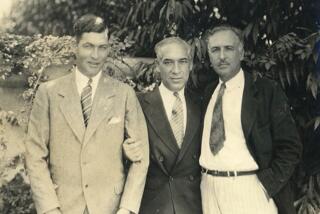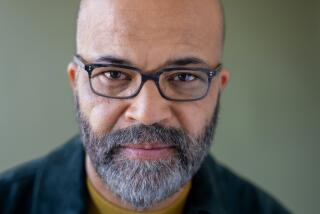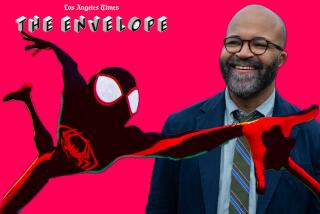Unmasking Frank Lloyd Wright
Somewhere out there Frank Lloyd Wright may be laughing.
At least Brendan Gill hopes so.
Gill would hate it if the ghost of that titan of architecture, who died in 1959 at age 92, is moping around the Great Beyond--simply because Gillâs new biography paints Wright as a lying, profligate, ruthless, egocentric genius.
It certainly would be uncharacteristic, Gill says, noting fondly that embarrassment was one of the few things that did not come easily to his friend Wright.
âHe didnât fear any future biography,â Gills says as he slouches in a chair on a Beverly Hills hotel sun deck, discussing Wrightâs maddening elusiveness. âHe seems not to have feared the fact that his own autobiography was a tissue of lies from beginning to end and that he was sure to be found out. Again and again in real life he was found out and he would never say anything except, âWell, there you are.â . . . A liar who once challenged just goes on to something else is a hard man to pin down.â
Some facts about Wright are beyond dispute, however. On a mundane level he is credited with such innovations as the carport. But Wrightâs fame generally is attributed to his adventurous, iconoclastic design spirit that created such unconventional buildings as New Yorkâs Guggenheim Museum. Houses designed by Wright--many are in Oak Park, Ill., where he practiced through the early years of this century--are maintained by owners as shrines to the architect. And it is widely suspected that Wright was the basis for the hero in Ayn Randâs monumental novel about an architect, âThe Fountainhead.â
Tourist Attractions
In short, Wright is a cult figure and, according to Gill, otherwise unremarkable towns can count on attracting tourists if they boast a Wright-designed building.
Gill has just published âMany Masks,â a densely worded and illustrated account of Wrightâs long life, a life that produced uncounted monuments--and plans for monuments--to Wrightâs design vision.
It also was a life that produced a hard core of mystery.
Despite all the documentation of Wrightâs career, the testimonials of his friends, lovers, wives, enemies and disciples, Wright remains an enigma, Gill says.
âThe greater you are, then the more essentially unknowable you are. Early on in the process of writing the book I decided that âMany Masksâ was the only appropriate title,â he says. âI could provide a description of, and some documentation for, a variety of masks but I was very leery of attempting a psychobiography. . . . There just isnât enough known about anybodyâs inner life.â
When it came to lying, Gill says cheerfully, Wright started early, shaving two years off his age by changing his birth date from 1867 to 1869. This is but one indication of Wrightâs obsession with image as detailed by Gill.
Almost shameless in his showmanship, Wright, a Wisconsin ârubeâ who became a sophisticate almost overnight, dressed with flair, often wearing a cape and a jaunty hat, according to Gillâs biography. And he sought publicity the way hounds chase rabbits, Gill says. When he wasnât in the headlines because of a scandal such as abandoning his first wife and six children for another woman, Wright was busy building his legend by giving press conferences and courting reporters, including Gill.
Yet even in this he was a paradox. He often complained about having his picture taken and then would pose until the photographer was practically ready to drop, Gill writes.
For whatever reasons, thatâs the way it was with Wright, who was constantly inventing facts about himself--possibly including his name, too--says Gill.
Gill, 73, is perhaps best known as a former theater critic for the New Yorker magazine and for his book about that periodical, âHere at the New Yorker.â He now writes a column on architecture for the magazine.
Gill is satisfied that the word genius is as close as he can come to understanding Wright, who he met and was charmed by in the architectâs old age.
âEverybody makes a great puzzle out of where did Shakespeare come from and how could he possibly have written about kings and noblemen since he himself was from so circumscribed a background,â Gill says. âThatâs perfectly nonsensical. If youâre a genius you can do anything. . . . Frank was unbelievably well self-educated. He had read everything at a very early age and yet he was a poor student, a dropout. . . . America in the 19th Century was full of remarkable eccentrics and Frank passes for a very good example of an authentic American genius-eccentric.â
Clearly, Gill is willing to forgive many of Wrightâs shortcomings.
âWhat I do feel strongly about is that Frankâs apparent excesses--his wildness, his lying, his ruthlessness, his ransacking people (for money, ideas, love, adoration)--are also characteristics of many of us,â he says. âBut we donât get into history unless we start murdering people and getting into the tabloids. Dentists and truck drivers are much more troubled people in many cases than the great people.â
Gill admits that he was charmed by Wright when he first met him on assignment for the New Yorker in the 1940s. Among other things, Wright granted him the rare privilege of calling him by his first name. In âMany Masksâ Gill recalls that Wright would call him up âand say, âHello, Brendan, this is Frank,â and I felt as if George Washington were telephoning me from Mount Vernon and saying, âHello, Brendan, this is George.ââ
Asked for Loans
While he was alive, Wright was forgiven much, particularly when it came to money. A lavish spender and always in debt, Wright constantly hit up friends, acquaintances and likely strangers for loans, according to Gill. In his native Wisconsin, Gill says, Wright chiefly is remembered for his slowness--if creditors were lucky--in paying bills. At a low point in his career, Wright went on the lecture circuit but never made more than around $200 per appearance, a pittance for a man with Wrightâs extravagant habits, he says.
In fact, Wrightâs ways with money produce their own baffling, if prosaic, mysteries. At one point in âMany Masksâ Gill throws up his hands, confessing that he finds it impossible to determine how Wright supported himself during one five-year period when he had little or no apparent income.
But while Gill charges in the book that Wright was âa confidence man,â in the interview he is quick to point out that Wright had qualities that were priceless.
Patrons who had âsworn that they would never have anything to do with him ever again as long as they livedâ were âwithin two or three years coming back and pleading with him to do another piece of work for them,â Gill says. âIn that case, the answer is, in part, everybody had his life intensified by Wright. One felt in his presence a real heightening of the promise of oneself.â
Intensity of Persona
More than a quarter century after his death, Wrightâs intensity still manifests itself, Gill says. âPeople do sort of expect him to come into the room. This is a sign of a certain quality in people, that they donât recede (after death), that they keep moving to the forefront. They have some vitality that is inexpungible.â
Wrightâs determination to make himself immortal probably forms the foundation of many of the buildings he designed, Gill says.
âThroughout history the need to outwit death has been through construction,â he says. â. . . Again and again we find that his works bear little relationship to the function for which they were designed.â
Wright once designed a church that does not look like a church, Gill says, adding that he also was famous for ignoring the wishes of clients in order to follow his own vision.
Pennsylvania House
For instance, a famous Wright house in Pennsylvania was supposed to overlook a waterfall. âThe one thing they wanted was a house that they could look at the waterfall from and the one thing that Frank gave them was the one place . . . that you canât see the waterfall from. Itâs on the waterfall,â Gill says with appreciation.
Now that he is something of a grand old man himself, Gill jokes that he soon may be able to adopt some of Wrightâs traits.
Heâd like to write a book about people he has known âwhen my memory is beginning to be totally unreliable and I will feel free to make up that which I am not too responsible to make up,â he says. âI will become more like Frank Lloyd Wright, I assume, as I approach senility than I am today. . . . I never met F.D.R. (President Franklin Delano Roosevelt). I have a strong impulse now to have met him. Pretty soon now Iâll be getting closer to the Oval Office and Franklin Delano and I will be like that, if I live to be old enough,â he says, raising two crossed fingers.
More to Read
Sign up for our Book Club newsletter
Get the latest news, events and more from the Los Angeles Times Book Club, and help us get L.A. reading and talking.
You may occasionally receive promotional content from the Los Angeles Times.









